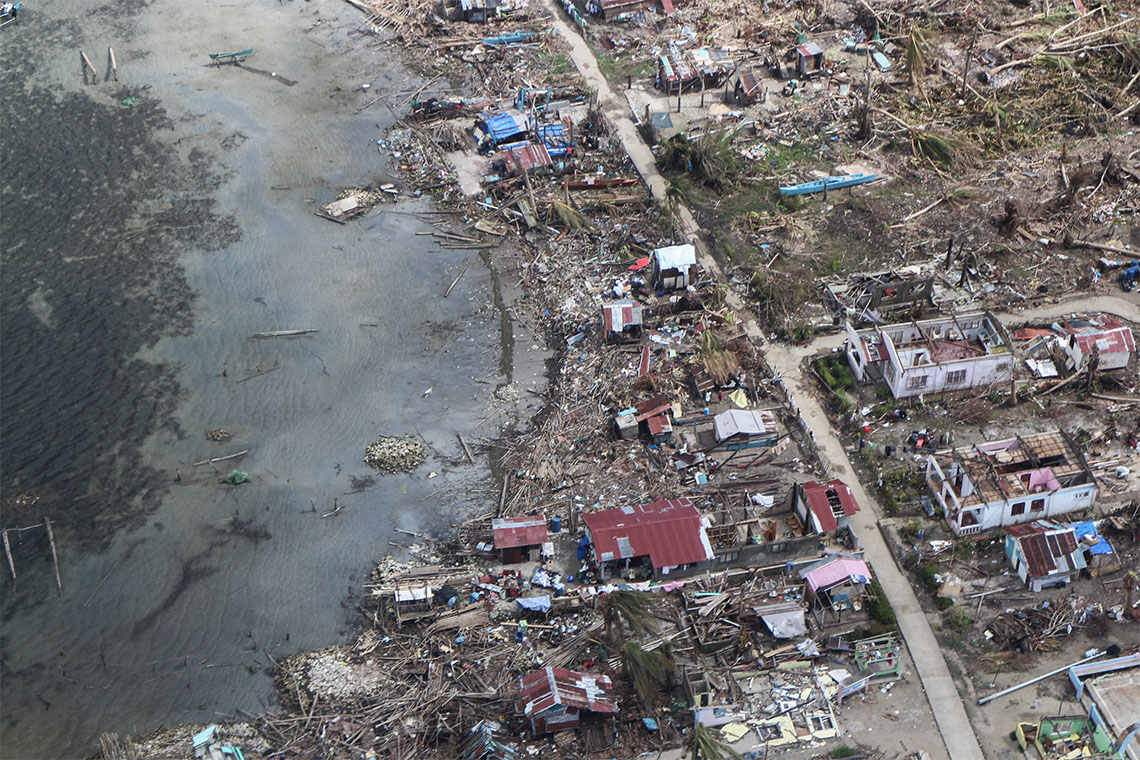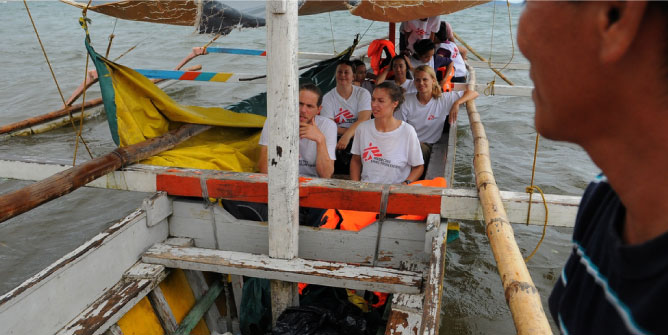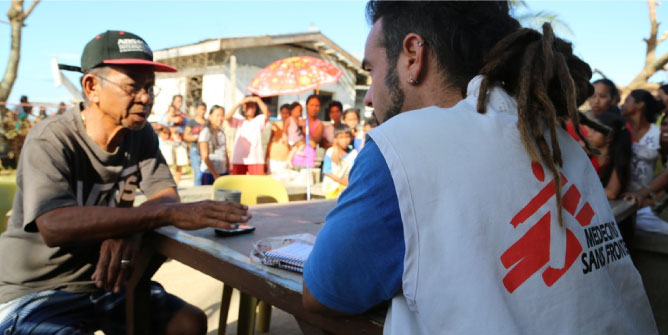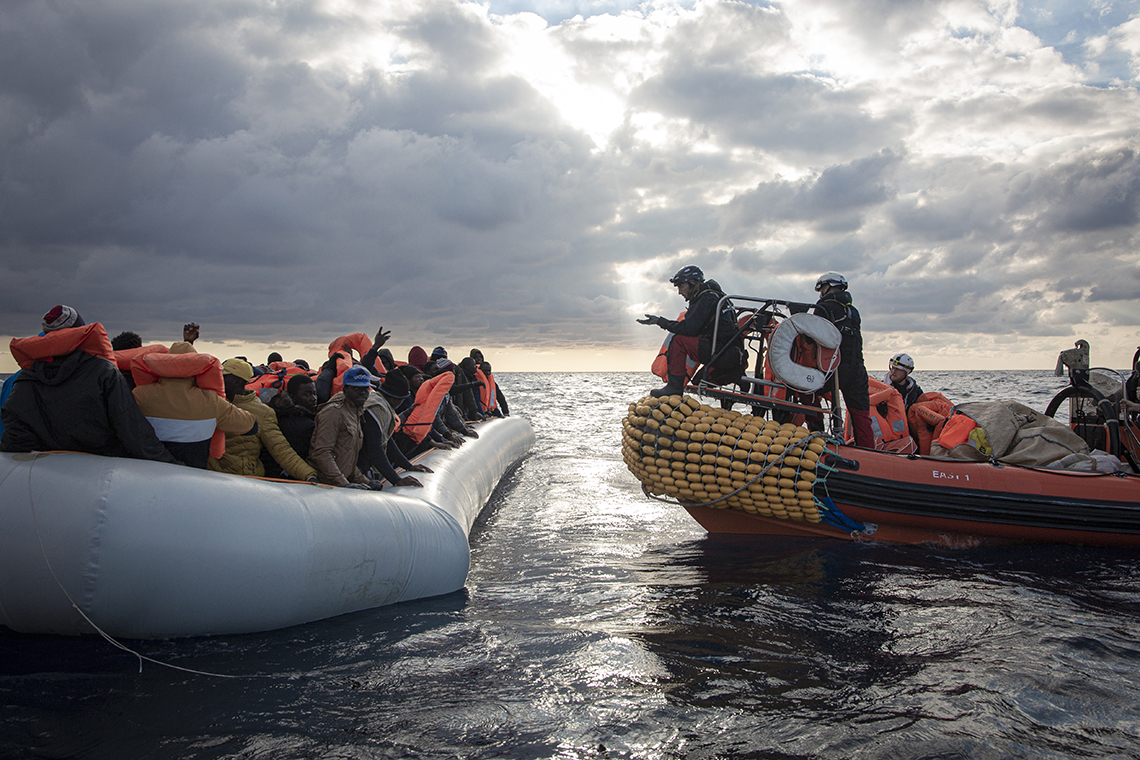Access

2013
Aerial view of Guiuan, a city of about 50,000 inhabitants located on a peninsula of Eastern Samar. Guiuan was the first city to be hit by Typhoon Haiyan and has been almost entirely destroyed. (Photo credit: ©️Francois Dumont/MSF)

TYPHOON HAIYAN
When Typhoon Haiyan, or Yolanda, as it is known locally, ripped through the central Philippines on 8 November 2013, it caused a disaster of a scale unprecedented in the past century in the country. Whole communities were flattened, while a tsunami-like storm surge claimed thousands of lives. Roofs were blown off and livelihoods were swept away.
Challenges: Access to affected communities on outlying islands hard hit by typhoon

Following the disaster, many areas were inaccessible; bridges were destroyed, roads were impassable, power and communications were cut off, and fuel was in short supply. Partially damaged schools, stadiums and churches were turned into evacuation centres, where survivors crammed together waiting for help to come. Some 16 million people have either lost their homes or livelihoods, and more than 6,200 people were killed.
The Visayas region was hardest hit by the typhoon. Encompassing Leyte, eastern Samar and Panay islands, it is one of the poorest regions in the Philippines. This, combined with the sheer force of the wind and water and the scattered geography of the archipelago, presented extreme challenges - first for the survival of the population and second for the delivery of relief.
Adaptation: Mobilising all means to assess the affected communities

In light of these tremendous efforts being focused on Tacloban, one of the hardest hit areas, was the centre of rescue and relief operations and media attention. And the scant information being received from outlying islands, MSF decided to split its team to assess the needs in other areas.
MSF teams went to the provinces of eastern and southern Samar, northern Cebu, northern and southern Leyte, Panay, Negros Occidental and Palawan to assess the extent of the damage and the needs. These areas were particularly challenging to access, so MSF mobilised all possible means to do so, including boats, trucks, chartered planes, commercial flights and helicopters.

The MSF team, consisting of a medical doctor, nurses, a psychologist and a logistician, travelled by boat to the remote coastal village, which cannot be reached by road. (Photo credit: ©️Florian Lems/MSF)

Two mobile medical teams – one land-based, the other travelling by boat – ran mobile clinics to reach inland villages and outlying islands. They were particularly important because they made primary healthcare services and referrals for more advanced care available to people who were otherwise isolated or without access to medical services.
Within days of Typhoon Haiyan, MSF was able to provide emergency assistance to communities on three of the most affected islands : Guiuan and nearby towns on eastern Samar; Tacloban, Tanauan, Ormoc, Santa Fe and Burauen on Leyte; and Estancia, Carles and San Dionisio on mainland Panay, as well as several outlying islands. This included addressing acute and immediate medical trauma needs; restoring basic medical services and facilities; providing shelter, reconstruction kits, water and sanitation facilities; and offering psychosocial support to both children and adults.
In some remote places where MSF teams arrived 9 days after Haiyan, villagers told them they were the first aid to reach the locality. (Photo credit: ©️MSF)



2015
In an operation on 18th Feb 2020, MSF and SOS MEDITERRANEE teams have completed a rescue of 98 people from the Mediterranean. While deteriorating weather conditions threatened to collapse the rubber boat's fragile structure, all survivors were safely evacuated to Ocean Viking. (Photo credit: ©️Anthony Jean/SOS MEDITERRANEE)

SEARCH AND RESCUE IN THE MEDITERRANEAN
People from Asia and Africa crossing the sea and land border into Europe without visas or permission has long been an issue. We saw the number reach its highest level in 2015 with more than 1 million arrivals.
Every year, thousands of people fleeing violence, insecurity, and privation at home attempt a treacherous journey via North Africa and across the Mediterranean Sea to Europe. Countless lives are lost during the passage. The vast majority of people attempting the Mediterranean crossing pass through Libya, where they are exposed to horrific levels of violence, including kidnapping, torture and extortion.
Challenges: Countless lives lost while crossing the Mediterranean Sea

In different periods of the EU migration policy, people were either confined in camps on Greek & Italian islands waiting for refugee qualification or repatriation, or went on another border crossing journey all the way to countries more open to them.
Many attempts though failed. People died at sea or they were caught and sent back by EU, Turkish and Libyan coast guards.
Adaptation: Operate search and rescue vessels to save lives

In total, MSF teams took part in 682 search and rescue operations and assisted more than 81,000 people between 2015 and the end of August 2020. Basic medical and mental health services were also provided by MSF.
In late 2016, the SAR operations were accused of being a "pull factor" for migrants and refugees to attempt dangerous sea journeys and of "deteriorating maritime safety". Following severe security threats by the Libyan Coast Guards towards humanitarian NGO vessels, MSF partially suspended SAR activities in Aug. 2017.
.jpg)
Search and Rescue Operations in the Mediterranean. A rubber boat in distress with 130 people on board is rescued by the Vos Prudence. The ship, with 13 MSF staff members on board and 18 non-MSF crew, can transport approximately 600 people, with contingency for another 400. (Photo credit: ©️Albert Masias/MSF)

In view of these accusations, MSF and UK university researchers carried out an analysis of the available data on attempted sea crossings. It showed that the numbers of people attempting the crossing were not affected by rescue NGO's presence or absence but that coastguard activity against smugglers could increase the dangers to migrants. Rescue boats though did substantially decrease the number of deaths.
Since 2018, our SAR operations had encountered ever-larger obstacles.Our boat was stripped of its flag and registration by the Gibraltar and Panama Maritime Authorities, and then an Italian court applied to seize the boat because of what MSF believed were spurious claims of waste mismanagement.
Between Dec. 2018 and July. 2019, MSF had no SAR activities. We returned to sea in July but in Sep. 2020 our boat was blocked from leaving port by Italian authorities. That detention lasted six months.
MSF returned to search and rescue activities in May 2021, saving the lives of people in distress trying to leave Libya, using our own chartered ship, the Geo Barents.
GeoBarents operates a rescue of 26 people including 15 unaccompanied minors from a small wooden boat 44NM off Sabratha. Everybody is safely on board. While the rescue was ongoing, the Libyan coast guard verbally intimidated and threaten the MSF teams via VHF. (Photo credit: ©️Avra Fialas/MSF)

.jpg)
Search and Rescue Documentary - Human Cargo:











